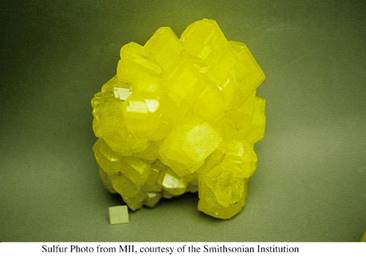Sulfur is the third most common mineral in the body (after calcium and phosphorus). An adult human body is ~4% sulfur ( ~100mg).
Sulfur is needed to regenerate cells. Sulfur's primary function is to enable oxygen transport across cell membranes; also used to make amino acids / protein;
Known as a healing mineral, a sulfur deficiency often leads to pain and inflammation associated with various muscle and skeletal disorders. Sulfur is especially known for its role in the disulphide bridge (S_S) between peptide chains, a structural component of many proteins, E.g. in skin's collagen, GAGs (E.g. chondroitin sulfate) in cartilage, and keratin in nails and hair. The high sulfur content / # of S-S bridges in nails makes them hard, whereas fewer S-S bridges provide desirable flexibility/softness in skin and cushioning in cartilage.
An essential mineral, we must obtain sulfur from our diet or an external source. The body can not make or store it;
Main dietary input is from:
Fish, beef, poultry, eggs
For therapeutic use, we can also obtain organic sulfur from MSM and/or DMSO

Sulfates - Inorganic sulfate (SO42-) provided in food and water, is required for the synthesis of many important sulfur-containing compounds in the body:
Sulfur oxide processed into sulfuric acid. Sulfuric acid is toxic and poisonous to the human body and cannot be digested, absorbed, or assimilated by the human body;
Eg. Sodium Lauryl Sulfate (SLS) /Sodium Laureth Sulfate (SLES) - esters of sulfuric acid, commonly used in many soaps, shampoos, detergents, toothpastes; mimic the estrogen hormone;
Sulfites. Sulfur preservatives, such as sulfites and sulfur dioxide, inhibit the growth of microorganisms and prevent discoloration of foods. Sulfur preservatives are used in fruit juices, dried fruits, vinegar and wine to extend the shelf life of products.
Organosulfur in amino acids E.g. methionine, cysteine, components of protein;
Organosulfur MSM (Methylsulfonylmethane). Found in rain water, fresh fruit and vegetables, raw milk from pastured cows
Earth's sulfur cycleOcean algae and several forms of plankton absorb massive amounts of inorganic sulfur from seawater converting it into an organic form. When these algae and planktonic organisms die, enzymes break down their organic sulfur molecules into DMS (Dimethylsulfide). Poorly soluble in water, this volatile compound collects in the stratosphere, where it is oxidized via the sun's UV light into DMSO (Dimethylsulfoxide), and then further converted into MSM (Methylsulfonylmethane). DMSO and MSM are highly soluble in water and concentrate easily in atmospheric water vapor, returning to earth in the form of rain, where these sulfur sources are concentrated (up to a hundred-fold within 4 hours) by plant roots, which convert it into sulfur-containing amino acids methionine and cysteine . The sulfur cycle is symbiotic and vital for life as we know it. The sulfur cycle may have "broken" in countries that exchanged manure for chemical fertilizers. In 1954, chemical fertilizers were mandated by the U.S. government, but the agribusiness fertilizers such as ammonium nitrates and sulfates lack bioavailability. Sulfur, with an atomic number of 16, bonds easily with many elements and molecular compounds, weakening the sulfur's bio-availability. Concerned about rising disease rates, and thinking that it was related to cadmium levels in chemical fertilizers, Finland banned them in favor of organic fertilizers and their disease rates are reported to have since dropped dramaitcally. Newer studies strongly suggest that it is in fact the increase in sulfur intake that has wrought the beneficial health changes. The Effects of Sulfur Amino Acid Intake on Immune Function in Humans, Univ of Southhampton, UK, 2006 |